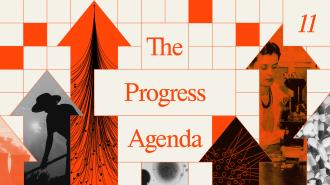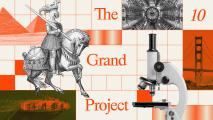The following is Chapter 11 from the book The Techno-Humanist Manifesto by Jason Crawford, Founder of the Roots of Progress Institute. The entirety of the book will be published on Freethink, one section at a time. For more from Jason, subscribe to his Substack.
The bold, ambitious future is waiting for us. How do we pursue it?
We have the flywheel of progress on our side: progress is a self-reinforcing process. The bigger the world economy, the more resources we have to invest in research and new ventures, the more we will increase total factor productivity, and the more we will grow the economy, in an accelerating cycle.
But the cycle does not operate purely through technological and economic factors. It is mediated by institutions: universities and laboratories, VC and other finance, law and regulation. Institutions develop and allocate both human and financial capital. And institutions, along with all of our activities, are shaped by culture.
Over most of the long sweep of history, institutions and culture improved along with science and technology. In the last four centuries, we developed the scientific method, constitutional democracy, research universities, limited liability corporations, stock exchanges, venture capital. Many of these developments were motivated by progress; all of them helped accelerate it.
But in the 20th century, this loop of the flywheel broke down and even went into reverse. Our institutions today are saddled with the twin legacy of the 20th century: the legacy of technocracy, which left our institutions overly centralized and bureaucratized, and the legacy of the counterculture, which left us with an obstructionist vetocracy. And so, as I described in the introduction, we have deceleration in total factor productivity and per-capita GDP, fields such as manufacturing and transportation that are still using the same basic technologies as in the 1960s, rising costs in housing, education, and healthcare, and a general inability to build or to operate.
Our societal sclerosis is partly the result of deliberate sabotage, motivated by the romantic backlash against progress: the view of material progress as a “destructive engine” and the goal of controlling it, slowing it down, or stopping it altogether. And it is partly a result of natural causes, the institutional senescence that can be staved off only through eternal vigilance. That kind of vigilance requires that our most capable leaders are motivated to maintain institutional competence, and that the public still cares enough about progress to support their efforts. Those values are fostered by a positive and confident philosophy of progress; they disintegrate without one.
The progress agenda is thus one of institutional and cultural reform, in three main cause areas: our laws and regulation, the way we manage research, and the culture of progress itself.
Law & regulation
There are problems we don’t yet know how to solve: curing cancer, or building nanotech. For these, we need advances in science and technology. Then there are problems we know how to solve, but prevent ourselves from solving. These are social problems, and they need legal and regulatory reform.
Building enough housing, for instance, is technologically a solved problem. And yet, we don’t build enough housing to meet demand, and both home prices and rents continue to hit all-time highs. One major index of US home prices has risen over 4x since 1990. The median single-family home price is now 5x the median household income; a price-to-income ratio of 3 is generally considered affordable. In 1990, over 70 of the top 100 US metro areas were under this ratio; now almost all of them are over it.1 An influential essay in Works in Progress magazine titled “The Housing Theory of Everything” argues that, in addition to the direct cost, more expensive housing hurts productivity, since people can’t move to where better jobs are; slows innovation, which benefits from density of talent; and makes it harder for people to have as many children as they would like.2
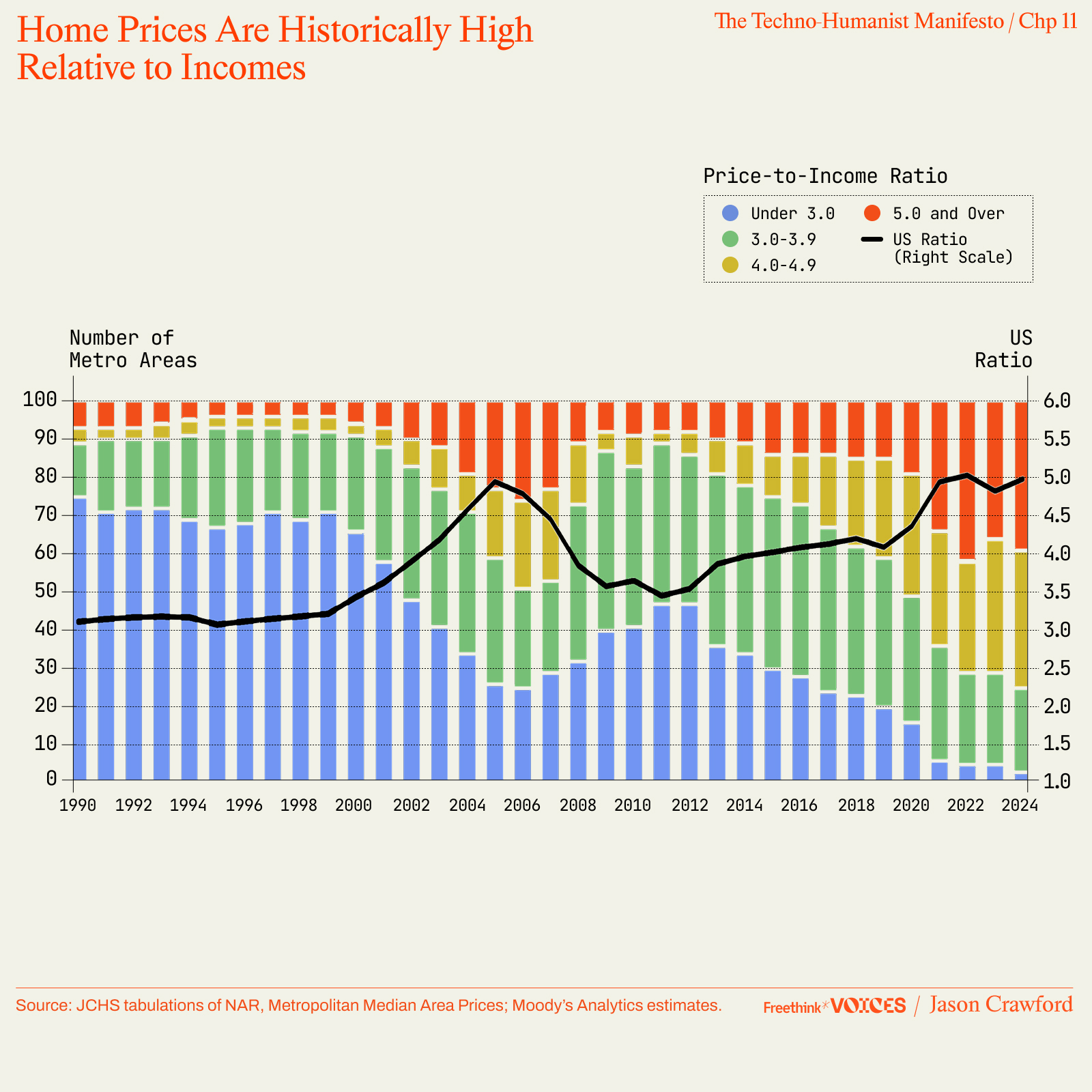
Economists such as Ed Glaeser argue persuasively that the problem lies in land-use regulations that artificially restrict housing supply. Since the 1960s, he writes in a Brookings report, we “changed from a country in which landowners had relatively unfettered freedom to add density to a country in which veto rights over new projects are shared by a dizzying array of abutters and stakeholders.”3 In short, housing is a social problem. We have to get out of our own way, by reforming the zoning restrictions, permitting processes, and building codes that restrict supply.4
But the building problem is much broader than just housing. It affects any kind of infrastructure: transit, factories, power plants, electrical lines. As of the end of 2024, almost 1.6 TW of electrical generation capacity and over 1 TW of storage capacity was waiting in queues to connect to the grid.5 “There is more power in the queue than on the grid today. The average wait time in the interconnection queue is five years and growing, primarily due to permitting timelines. In addition, many projects are cancelled due to the prohibitive cost of interconnection.”6
The permitting problem is broad and varied, but one law at the core is NEPA (the National Environmental Protection Act). NEPA requires that all federal agencies, in any “major action” that will significantly affect “the human environment,” must produce a “detailed statement” on those effects, now known as an Environmental Impact Statement (EIS). As Eli Dourado recounts, in the early days, an EIS was less than ten pages, and would go unchallenged. But activists learned to obstruct projects using litigation, by charging that an EIS failed to address some important detail. Every time they won, it raised the standard for how detailed an EIS had to be. Court rulings set precedents that “major action” actually means any action, and “human environment” actually means the entire environment. Over the decades, this process ratcheted up, until today, an average EIS runs several hundred pages (plus over a thousand pages of appendices!) and takes almost 5 years to complete. And if a federal action will not affect the environment, it requires yet another type of statement to confirm this—which now creates more paperwork than the EISes themselves.7
NEPA has now become a barrier to projects including housing, transmission lines, semiconductor manufacturing, congestion pricing, and even offshore wind.8 None of this was anticipated or intended by Congress or even by environmental activists, who now find even their own “green” projects stifled by the law. Dourado recommends four reforms to bring NEPA back to its original purpose: trust agencies to make findings of no impact without an assessment report; do not require public hearings or comment for every environmental review; raise the bar for judicial injunctions; and establish an exemption for decisions with a strong national interest.9
NEPA is a procedural law: it mandates a process to be followed, but doesn’t require any specific outcome. Alec Stapp and Brian Potter at the Institute for Progress contrast this with substantive environmental regulation, which mandates outcomes, such as limiting the amount of carbon monoxide that can be emitted from an automobile. Procedural laws are more flexible, but that very flexibility allows them to be weaponized by activists against growth. “We need a new era of environmentalism that learns from the successes and failures of the past,” they conclude. “Environmentalists rightly tout triumphs over acid rain, ozone depletion, DDT, and lead exposure. But these wins were not the result of preparing ever longer environmental impact statements for specific projects. They were the product of putting a price on pollution, via cap and trade programs, or outright banning a pollutant when necessary.”10 We could use a shift away from procedural and towards substantive regulation.
More broadly, Michael Catanzaro suggests that we have conflated permitting with compliance. Our processes emphasize obtaining approval, but what actually matters is following the rules. Instead of lengthy and burdensome permitting processes, he suggests, permitting should be made a simple matter of submitting information and certifying that a project will follow the law. Permits would be approved by default unless the information were incomplete or fraudulent, within a tight time window, say 90 days. Then, the enforcement focus could shift to compliance: auditing that a project is in fact following applicable regulations, such as pollution limits.11
Permitting affects all projects, but some industries get special treatment. Nuclear energy, for decades, has faced one of the most burdensome regulatory regimes, which make it slow and expensive to build nuclear plants, and ultimately make nuclear power uneconomical. NuScale Power, after going through its design certification with the NRC (Nuclear Regulatory Commission), complained that they had been “required to evaluate events with frequencies orders of magnitude less than the Commission’s safety goals or the 10–6 per reactor year limit the Commission has stated as a threshold of credibility, and in some cases even where no core damage would result.” The costs of the application exceeded half a billion dollars; NuScale states dryly that this level of effort “may not be repeatable for future reviews.”12
It doesn’t have to be this way: one analysis of worldwide nuclear construction since 2000 finds that in South Korea, India, China, and Japan, costs are about 4x lower than in the US or UK.13 France built enough nuclear plants in the 1980s and ’90s that about two-thirds of its electricity is now nuclear (compared to about 20% in the US and only 10% worldwide).14 We could do the same. There are many credible proposals for reform,15 but fundamentally what we need is change in regulatory culture: a commitment to balance costs and benefits, and an NRC that sees the development of energy as its job.
Or take the FDA. To bring a new drug to market now takes around 12 years and over $1 billion,16 and the costs have grown over time, as noted in a well-known paper by Jack Scannell et al that coined the term “Eroom’s Law” for this phenomenon. The paper suggests four factors driving the cost of drugs; some of them are inevitable low-hanging fruit effects, but one of them is over-cautious regulation: “Each real or perceived sin by the industry, or genuine drug misfortune, leads to a tightening of the regulatory ratchet, and the ratchet is rarely loosened, even if it seems as though this could be achieved without causing significant risk to drug safety.”17 In many cases, the FDA has been too conservative in its approvals, adding needless delay that holds back treatments from patients. Omegaven, a nutritional fluid given to patients with digestive problems (often infants) that helped prevent liver disease, took fourteen years to clear FDA’s hurdles, despite dramatic evidence of efficacy early on, and in that time hundreds to thousands of babies died preventable deaths.18 A former FDA regulator has stated that in the 1980s, approval of the new drug application for human insulin was delayed despite compelling evidence of safety and effectiveness, because his boss said: “If anything goes wrong, think how bad it will look that we approved the drug so quickly.”19 One Bayesian analysis that modeled the tradeoff between approving bad drugs and failing to approve good drugs found that the FDA is much more conservative than optimal, especially for terminal illnesses with no existing therapies.20
The problem with regulatory agencies is not that the people working there are evil—they are not. The problem is the incentive structure: Regulators are blamed for anything that goes wrong. They are not blamed for preventing growth and progress. They are not credited when they approve things that lead to growth and progress. So all of the incentives point in a single direction: towards more stringent regulations. And when regulations are put in place, they become very hard to remove. So regulation ratchets upwards.
Nuclear and drugs, at least, were not outright banned. Supersonic flight was. Since 1973, FAA regulations have made it illegal to fly faster than the speed of sound over land in the US; several other countries followed suit.21 A 2025 executive order, which I trust will be faithfully implemented, has directed the FAA to repeal the speed limit and replace it with a noise limit instead.22
This is just an amuse-bouche of the issues involved. Summarizing the theme, Derek Thompson has called for an “abundance agenda” for America, and his book with Ezra Klein on this topic, Abundance, has made a splash in DC.23 Gavin Newsom has now endorsed an “Abundance Agenda” for California, and a bipartisan “Build America Caucus” has launched, inspired by the same ideas.24
We should take pains to prevent this agenda from succumbing to the tribalism of contemporary politics. Thompson has suggested that it could “take the best from several ideologies”:
It would harness the left’s emphasis on human welfare, but it would encourage the progressive movement to “take innovation as seriously as it takes affordability,” as Ezra Klein wrote. It would tap into libertarians’ obsession with regulation to identify places where bad rules are getting in the way of the common good. It would channel the right’s fixation with national greatness to grow the things that actually make a nation great—such as clean and safe spaces, excellent government services, fantastic living conditions, and broadly shared wealth.25
Growth and progress should be a shared, cross-partisan goal. With progress as the standard to measure our efforts, all sides can then debate, using history, data, and logic, whose policies will actually achieve that goal. A world in which every party was competing to be the party of progress would be far healthier than one absorbed in redistribution and identity politics.
Research institutions
“By many measures, the biological and medical sciences are in a golden age. That fact, which we celebrate, makes it all the more difficult to acknowledge that the current system contains systemic flaws that are threatening its future.”
So begins a perspective piece published in 2014 by four biologists, including the founding chair of the Department of Systems Biology at Harvard, a former president of Princeton, and a Nobel laureate who formerly directed the NIH.26 The paper laments that “biomedical scientists are spending far too much of their time writing and revising grant applications and far too little thinking about science and conducting experiments.” It also warns about “conservative, short-term thinking in applicants, reviewers, and funders”:
The system now favors those who can guarantee results rather than those with potentially path-breaking ideas that, by definition, cannot promise success. Young investigators are discouraged from departing too far from their postdoctoral work, when they should instead be posing new questions and inventing new approaches. Seasoned investigators are inclined to stick to their tried-and-true formulas for success rather than explore new fields.
Others sound a similar warning. In an editorial for the London School of Economics Business Review, Donald Braben and Rod Dowler write: “It is of vital importance right now to avoid suppressing genius in favour of apparent practicality.” They warn that “freedom of research has been severely curtailed”:
Current policies make sense for incremental or near-market research that may well lead to the creation of new technologies based on existing fundamental theories. The casualty of such policies, however, will be hard-to-predict radical discoveries … Uninhibited exploration of these fields would almost certainly reveal unimaginable opportunities for growth and enrichment. However, they are in danger of being strangled by bureaucratic processes that would have denied funding for many of the 20th century’s major discoveries.27
And Sydney Brenner, a medical professor at Cambridge and Nobel laureate, says:
The supporters now, the bureaucrats of science, do not wish to take any risks. So in order to get it supported, they want to know from the start that it will work. This means you have to have preliminary information, which means that you are bound to follow the straight and narrow.28
In an obituary for Fred Sanger, two-time Nobel laureate who pioneered the sequencing of both proteins and DNA, Brenner writes:
A Fred Sanger would not survive today’s world of science. With continuous reporting and appraisals, some committee would note that he published little of import between insulin in 1952 and his first paper on RNA sequencing in 1967 with another long gap until DNA sequencing in 1977. He would be labeled as unproductive, and his modest personal support would be denied. We no longer have a culture that allows individuals to embark on long-term—and what would be considered today extremely risky—projects.29
Similarly, Peter Higgs, whom the Higgs boson is named after, has said:
It’s difficult to imagine how I would ever have enough peace and quiet in the present sort of climate to do what I did in 1964. … Today I wouldn’t get an academic job. It’s as simple as that. I don’t think I would be regarded as productive enough.30
A threat to future scientific breakthroughs is a threat to progress. What has gone wrong?
Accounts differ; what follows is an opinionated and probably oversimplified narrative. In short, I blame two factors: First, the centralization of funding, which has come to be dominated by a small number of large agencies. Second, an increase in competition among researchers, which has created overoptimization for markers of performance that lead to jobs and grants but not necessarily to great science.
The dominance of a few federal agencies in research funding is a post-WW2 phenomenon. During the war, the Office of Scientific Research and Development, under the great Vannevar Bush, developed not only weapons but also peacetime technologies such as radar and penicillin.31 Motivated by these successes, both the scientific establishment and the government wanted to keep the collaboration going into peacetime. Bush famously wrote a report to the President, “Science: The Endless Frontier,” in which he advocated for federal funding of basic research as the means to American prosperity and security.32 Bush’s specific proposals were not adopted, but federal funding for science ramped up massively in the 1950s and ‘60s.33 For decades, US universities have gotten the majority of funding for science and engineering R&D from federal sources such as the NIH ($44B in 2024), the NSF ($7.4B), and DARPA ($4.1B).34
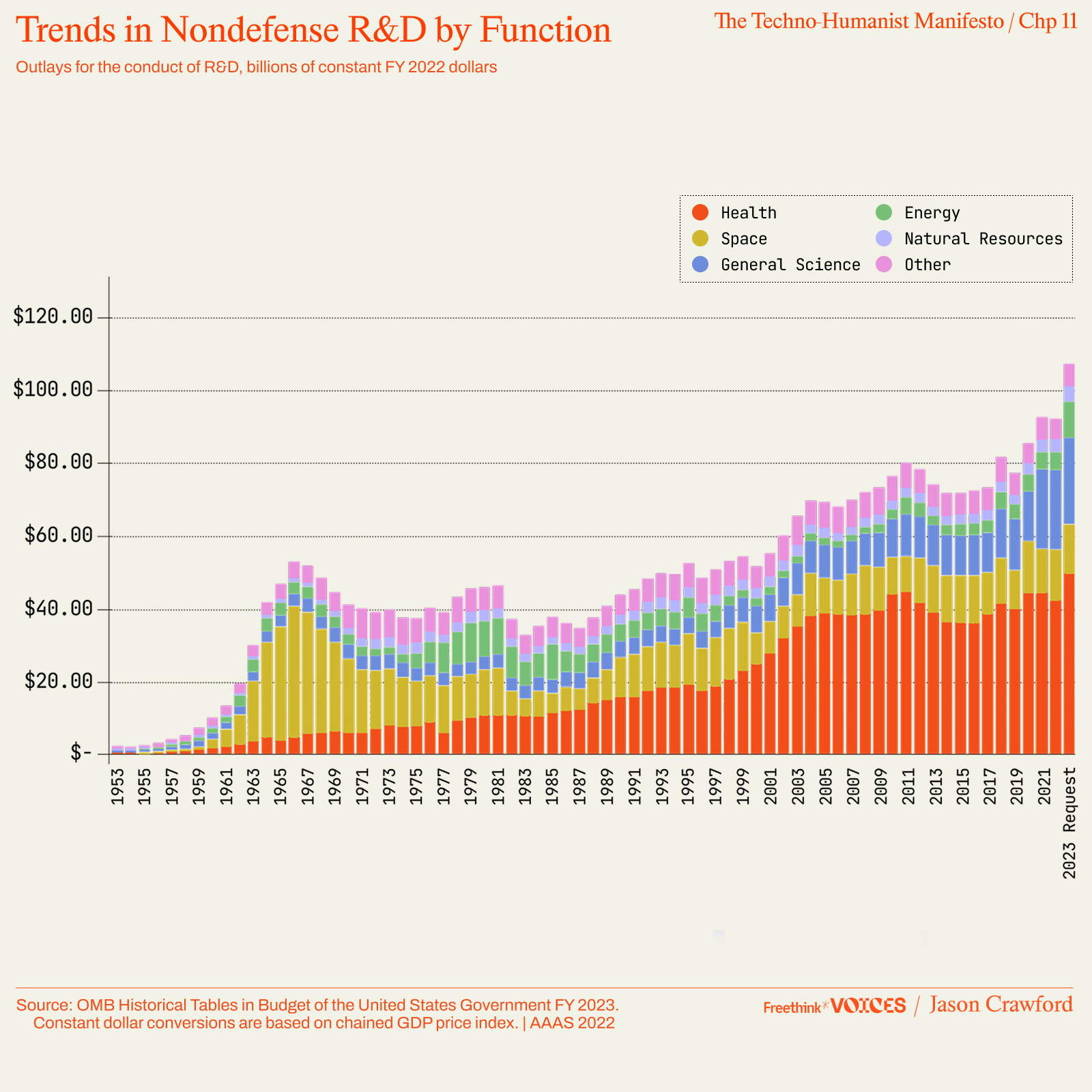
Even as the supply of funding grew, however, demand grew faster. The NIH, for example, received 9,199 grant applications in 1970, and made 3,264 awards; in 2024 it received 6 times as many applications, but only made 3 times as many awards. Thus while the success rate on NIH grants was 30–40% in the 1970s, for the last 20 years it has hovered around 20%.35 It doesn’t help that the NIH’s budget, adjusted for inflation, has not increased since 2003.36
Several consequences flow from all of this.
A key problem with centralization of funding is that any one funder, no matter how well-intentioned and wise, will have blind spots. Katalin Karikó, who shared the Nobel prize in 2023 for mRNA technology, was repeatedly denied grants for her work and was even demoted for failing to raise funds.37 Stanley Prusiner won a Nobel in 1997 for discovering prions, but his work was “treated as heretical,” he struggled to get funding from the NIH, he was dropped by the Howard Hughes Medical Institute, and he initially failed to get tenure at UCSF.38 Research that led to the breast cancer drug Herceptin was denied funding from NIH, and was ultimately supported by private sources including the cosmetics company Revlon.39 Similar stories are told about early work on biodegradable polymers, insulin manufacturing, neural networks, genome sequencing, and expansion microscopy—they are not the exception, but the rule.40
The creation of a virtual monopsony for research also allows funders to be insensitive to the needs and desires of researchers. Thus, the grant process has grown slow, cumbersome, and restrictive. One institute within the NIH advises: “Your overall process from planning to award may take as long as two years—even longer if you need to resubmit.”41 (Resubmission is common.42) The process can be tripped up for trivial reasons, such as minor variations in font size on grant applications.43
Further, since grants come from taxpayer money, they face pressure for oversight and accountability. NIH grants require prior approval for any “change in the direction, aims, objectives, purposes, or type of research training,” including a change in animal model, a shift in emphasis to a new disease area, a change in assay or other new technology, any equipment purchase over $25,000, and any rebudgeting by more than 25% in any category.44 Accountability is an understandable goal—but it is directly at odds with the autonomy that scientists need to do great research.
Risk aversion may be exacerbated by the committee-based peer review of grants, a process used by the NIH and NSF. Committees tend to make consensus decisions, but scientific breakthroughs often challenge consensus. And when the committee is formed of experts in the field—essentially, the competitors of the researchers submitting the proposal!—there is a risk that a field converges on a consensus too quickly, prematurely pruning off branches of the search space. Some Alzheimer’s researchers, for instance, believe the field has suffered from an overfocus on amyloid proteins as the cause of the disease; one of the more emphatic has even claimed: “If it weren’t for the near-total dominance of the idea that amyloid is the only appropriate drug target, we would be 10 or 15 years ahead of where we are now.”45
To its credit, the NIH, at least, recognizes the problem. Starting in 2004, they created a series of new grant types “out of concerns that the traditional NIH peer review process had become overly conservative, and the belief that NIH required specific means to fund high-risk research.”46 The High-Risk, High-Reward Research Program (HRHR) now includes the Pioneer Award, for researchers pursuing groundbreaking new directions, the New Innovator Award, aimed at early-career scientists, the Early Independence Award, which helps junior scientists skip their postdoc and jump-start their lab career, and the Transformative Research Award, for “groundbreaking, unconventional research with the potential to create new scientific paradigms.”47
The HRHR program, however, is less than 0.5% of NIH’s budget.48 Whatever good these grants have done, they don’t seem to be enough to have reformed the culture of research. Indeed, when the foundation Open Philanthropy reviewed a number of the Transformative Research proposals, they found them to be “a bit on the conventional side.”49 Even when researchers are solicited for transformative ideas, they are still influenced by the entrenched culture of risk aversion.
Some of these problems would be alleviated simply by having a larger number of smaller funders. Patrick Collison, a tech CEO and science philanthropist, has suggested that we break up NIH and NSF “into 10+ bodies with fully independent approaches. Every 5-10 years, reassess their budgets.”50 There is precedent for a more decentralized funding approach: much of the progress in agricultural science and technology in the US was funded not at the federal level but at the state level, through the state agricultural experiment stations established in the 1880s.51 This decentralization was crucial in the story of hybrid corn, considered one of the greatest breeding successes of the 20th century: in 1905, work by Edward Murray East on this project was discontinued at the Illinois experiment station, and it survived only because East was invited to continue it at the Connecticut station.52
More broadly than diversification in funding sources, though, we need diversification in organizational structures. The dominance of NIH and NSF has also meant the dominance of a particular model of research: relatively small labs, each led by a principal investigator (PI) who not only runs the lab but also fundraises for it, mostly in the form of relatively small, short-term, project-based grants.
The PI model forces one person to play several roles: research, management, administration, and fundraising; at many universities, teaching is added, not to mention serving as a reviewer for journal papers or grant committees. More importantly, it means that each lab has to sell itself to the outside world, to funders who don’t know the researchers and aren’t working with them closely or talking to them daily. This pushes grants more towards “legible,” incremental work.
Consider, in contrast, the UK Laboratory of Molecular Biology (LMB) in Cambridge, where thirteen scientists won nine Nobel prizes—including Watson & Crick for the structure of DNA, the aforementioned Fred Sanger for protein and DNA sequencing, and Venki Ramakrishnan for the structure of the ribosome. LMB researchers don’t have to rely on external grants: the entire lab is funded as a unit, and research projects are funded out of the core budget. A profile of the LMB in Science reports that researchers are encouraged to tackle big, difficult questions, despite the risk that entails, and that researchers have autonomy and aren’t under pressure to constantly publish. In the words of one group leader: “There’s a tradition of trying to hire smart people and then basically leaving them to it.” Ramakrishnan says that having secure, long-term funding allowed him to focus on discovering the structure of the ribosome. He also says that the lab has a collaborative atmosphere, since the success of any one researcher helps the entire lab do well.53 In a different interview, Sydney Brenner, another one of the lab’s Nobel laureates, commented:
… we never let the committee assess individuals. … We asked them to review the work of the group as a whole. Because if they went down to individuals, they would say, this man is unproductive. He hasn’t published anything for the last five years. So you’ve got to have institutions that can not only allow this, but also protect the people that are engaged on very long term, and to the funders, extremely risky work.54
James Phillips, a neuroscientist and former Science and Technology Advisor to the Prime Minister of the UK, points out that many of these features of the LMB also apply to celebrated institutions such as Bell Labs and Xerox PARC. All these labs had “a transformative impact on the world; a widely reported unique culture distinct to the mainstream; minimal obstacles to research; ability to pursue work that defied consensus; and a highly collaborative environment.” All had a single major funding source, providing “hands-off” funding that is open to speculative work, on a multi-decade time horizon. All had shared lab resources, rather than each lab accumulating its own resources in its own little “empire.” All allowed researchers to focus on research instead of management, administration, and teaching. And all evaluated their researchers internally, which is possible only with single-source block funding. In contrast, the typical approach has “each researcher being pulled in a different direction by different external funding criteria, in an atomising and soloist manner preventing the emergence of a vibrant community of people pulling in the same direction.”55
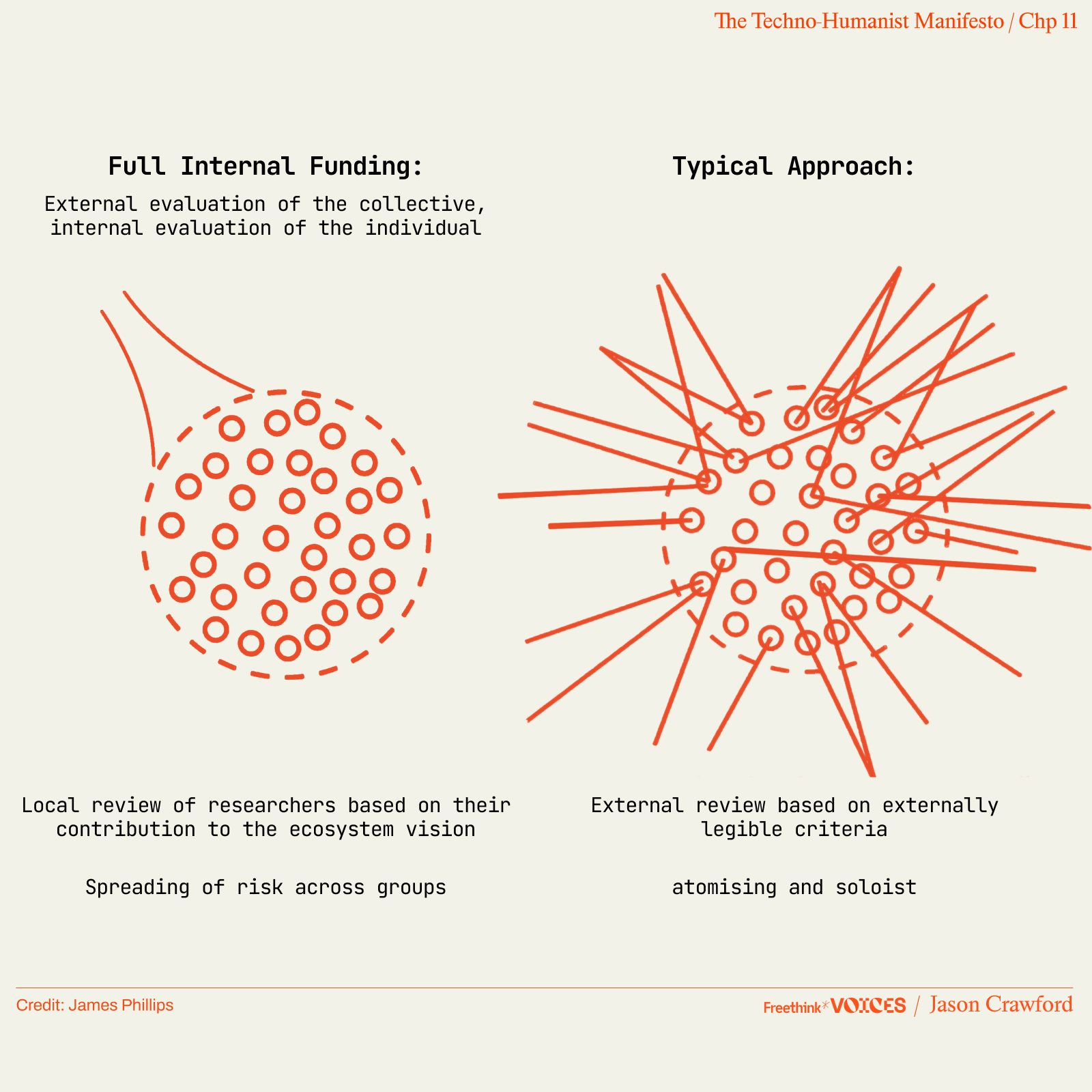
A modern biology lab applying some of these lessons is the Arc Institute, based in Palo Alto and partnered with Stanford, Berkeley, and UCSF. Investigators at Arc get their labs fully funded for renewable 8-year terms to pursue curiosity-driven research; institute co-founder Silvana Konermann says that they “want to take away the short-term demand to produce output.”56 This is made possible by $650 million in founding pledges, including from institute co-founder Patrick Collison. Although Arc was only founded in 2021, it has already announced the largest AI model trained on genomic data, which they have used to design an improved bacteriophage; a virtual cell model that they say is “to the best of our knowledge … the first model to consistently beat simple linear baselines;” and a new DNA editing technology that can make far more sophisticated edits than CRISPR.57
Another alternative to the principal investigator model is exemplified by DARPA. The DARPA model focuses on a program manager with a vision for an ambitious technological goal. The PM contracts out to labs to perform the work, but they control the vision and the budget. This model lends itself well to ambitious technological prototypes, and was the origin of the Internet and GPS.58 One privately-funded research organization based on this model is Speculative Technologies, which aims to unlock “big-if-true” technologies through “multi-year programs run by program managers with wide-ranging authority to coordinate several projects towards a single vision.”59 The newly-formed UK research agency ARIA also uses ARPA-style PMs.60
The PI model also doesn’t lend itself well to big scientific goals that require a large, coordinated team and a lot of funding: sequencing the human genome, or mapping the neural connections of the brain. An increasingly popular alternative is the Focused Research Organization (FRO), which is organized like a startup team with a CEO, but as a nonprofit with a goal to produce a public good such as an open scientific dataset.61 Convergent Research has now launched FROs for technologies including microorganisms for use in synthetic biology, software for proving mathematical theorems, ocean-based carbon dioxide removal, and brain-computer interfaces.62
Another problem caused by increased competition among researchers is the focus on the peer-reviewed journal paper as the measurable unit of work, with citations as the score. Academic career advancement, including tenure, has become closely tied to citation counts. Hyper-optimization around these metrics leads researchers to focus more on what they can publish than on good science. Seemay Chou, biologist and co-founder of the Astera Institute, writes: “In all my discussions with scientists across every sector, exactly zero think the journal system works well. … Scientists should probably be putting out shorter narratives, datasets, code, and models at a faster rate, with more visibility into their thinking, mistakes, and methods.” She calls journal publishing “fundamentally broken … one of the legacy systems that prevents science from meeting its true potential for society.” In a rare move, Astera refuses to fund journal articles, requiring that research they support “be released and reviewed more openly, comprehensively, and frequently than the status quo”—and not behind a paywall or with a restrictive license. The affiliated lab Arcadia Science prohibits its researchers from publishing in journals. When they made this change, Chou reports, it profoundly reshaped their science: “Our researchers began designing experiments differently from the start. They became more creative and collaborative. The goal shifted from telling polished stories to uncovering useful truths.”63
None of these models is a silver bullet. The point is that our ecosystem of research institutions has become dominated by a narrow set of organizational models. In “A Vision of Metascience,” Michael Nielsen and Kanjun Qiu argue that the ecosystem is in “a state of near stasis, with strong barriers inhibiting the improvement of key social processes.” Someone “seeking to achieve a scalable improvement in the social processes of science”—such as the founders of the organizations mentioned above—they call a “metascience entrepreneur.” They even envision a “metascience accelerator” that could provide support to such efforts, with the ultimate goal of “a flourishing ecosystem of people with wildly imaginative and insightful ideas for new social processes; and for those ideas to be tested and the best ideas scaled out.”64 This vibrancy is what the ecosystem of science needs.
Culture
The deepest roots of institutional change are cultural. Cultural change is thus the most important pillar of the progress agenda.
This begins with what our children are taught in school. Today, they are not taught the history or nature of progress. History classes focus on wars and empires; science classes teach concepts and frameworks; the story of technology and economic growth falls between the cracks. Steven Johnson, popular author of dozens of books on the history of technology, reports that in “an otherwise excellent American history textbook” covering the last 150 years, “labor” was mentioned 226 times, and “civil rights” 134 times, but “antibiotics” and “vaccines” were not mentioned once. “Something is fundamentally distorted in the emphasis here.”65
As a result, students graduate with no understanding of or appreciation for the system that created and maintains their historically unprecedented standard of living. Author Charles Mann has suggested: “All high-school students should be required to take a course called How the System Works”; he envisioned a course focusing on the systems that provide us with food, water, energy, and sanitation. “The overall theme: these systems, which required decades to create, are triumphs of the human mind and spirit, and it is the task of all of us to ensure that they are passed down to the next generation and improved. It should not be possible for so many terrific young men and women not to know anything about the systems on which their lives depend.”66
A basic understanding of industrial civilization—how it works and why we need it—should be considered an essential outcome of an education. Call it “industrial literacy.”
Industrial literacy could start in grade school. Students could learn basic facts relevant to economic life: what crops need in order to grow, what farmers do, and how pests or disease can damage the harvest; what types of materials our world is made of, and how things like metal, glass, ceramic, and textiles are produced; different sources of energy, how to harness them, and how to direct forces using simple machines such as gears and levers. They could learn the stories of specific inventions and inventors: Edison and the light bulb, Stephenson and the locomotive, Bell and the telephone. They could learn basic facts about economic history: that people once lived without heating, air conditioning, plumbing, or electricity; that most people worked manual jobs, and mostly on farms; that severe disease was common, especially in childhood. They could engage in many hands-on activities to get first-hand knowledge of historical and modern processes: gardening, weaving, carpentry, paper-making and printing, navigation with a compass. They could try going a day eating only food they had grown themselves, wearing only clothes they had sewn, or using light only from candles they had dipped.
Children learn through books and other media as well. I’ve found a few relevant books for my young daughter, such as Up Goes the Skyscraper; John Deere, That’s Who!, about Deere’s steel plow; and Magic Ramen, about Momofuku Ando and his instant noodles—but I and other parents I know wish there were more.67 There used to be. Steven Pinker tells us: “When I was a boy, a popular literary genre for children was the heroic biography of a medical pioneer such as Edward Jenner, Louis Pasteur, Joseph Lister, Frederick Banting, Charles Best, William Osler, or Alexander Fleming.”68 (How many of those names do you recognize?) Another children’s book, from 1959, was titled You Will Go to the Moon; one blogger recounts: “My husband (aged 51), was profoundly changed by this story as a boy.”69 Another series from the 1950s–’60s, “We Were There,” includes among its titles not only the Battle of Gettysburg and the Mayflower Pilgrims, but also the first airplane flight with the Wright Brothers, the completion of the transcontinental railroad, and the opening of the Erie Canal.70 Topics like these have fallen out of favor, leaving parents mostly with worn and yellowed books from decades ago. We need a new generation of children’s media, to retell these stories for today’s youth and to update them with heroes like Katalin Karikó and Steve Jobs.
By high school, students would be ready to grasp the concept of progress itself: they could see the advancement of science, technology and industry as part of a bigger, integrated historical narrative. They could learn how we solved the grand challenges of human existence: how we learned to feed the world, how we mechanized most labor, how we reduced mortality from infectious disease. They would be ready to approach economic history quantitatively, understanding the significance of crop yields, labor productivity, or energy usage per capita; they would learn key historical charts such as the “hockey stick” of world GDP growth, the dramatic declines in poverty and child mortality, the growth of literacy and democracy.
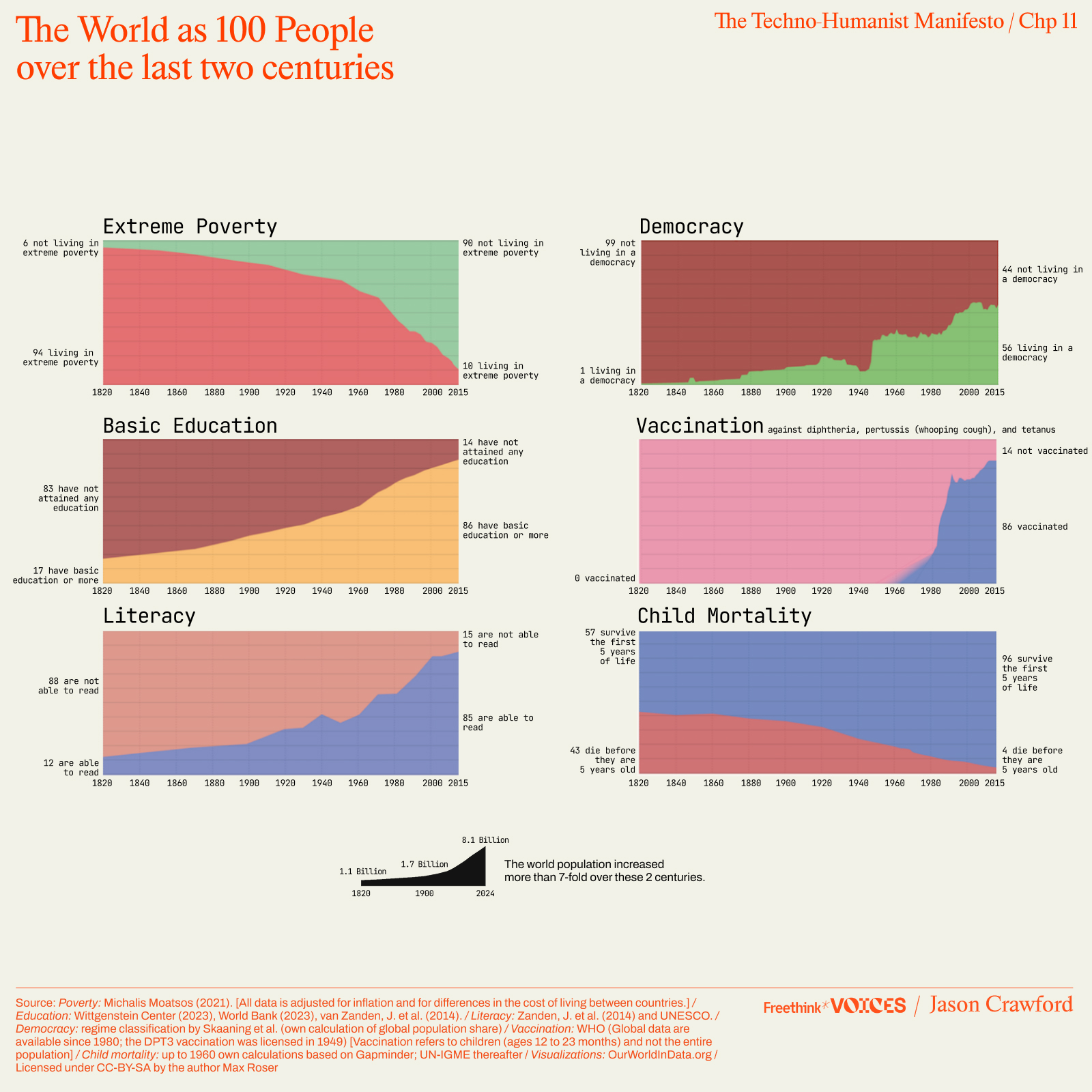
In university, “progress studies” could be an interdisciplinary field integrating ideas from economics, history, and philosophy.71 Students would deepen their understanding of these fields, and engage with the centuries-long conversation about the meaning and causes of progress. They would read historical texts like Bacon and Condorcet, contemporary perspectives from authors such as Julian Simon or Joel Mokyr, and critics of progress from Rousseau to Lewis Mumford. Some universities are already starting to offer such classes, such as the University of Toronto, where professor Kevin Bryan is giving a course starting Fall 2025 on “Progress: How to Get Big Things Done.”72
Students who graduated from such a curriculum would be cured of the “industrial amnesia” described in Chapter 1. They would not be “fish in water,” blind to technology and infrastructure all around them; they would see their world with wonder and gratitude. And rather than despair at inevitable doom for the world, they would have ambition to be a part of the story of human progress, to pursue our best opportunities and seek solutions to our biggest problems.
The great educator Maria Montessori saw progress as an essential part of the curriculum, for the purpose of moral development. Writing just after the World Wars, she felt acutely the need for human fraternity and unity—and she felt these were evident in the interconnectedness of society and the economy, and in the great discoveries and inventions made by those who came before us. Thus she wrote:
Children should be made to realise that all great achievements in culture and in the arts, all sciences and industries that have brought benefit to humanity, are due to the work of men who often struggled in obscurity and under conditions of great hardship; men driven by a profound passion, by an inner fire, to create with their research, with their work, new benefits not only for the people who lived in their times, but also for those of the future.73
When this was done in classrooms, she reports:
The children frequently asked to see the portraits of these heroes and delighted in relentlessly pursuing the near-miraculous significance of their work once they had a clear idea of the times in which they had lived, the degree of ignorance of their contemporaries with regard to their research and studies, and the dearth of means at their disposal.
A near-religious respect grew within them for these men who lived in such distant times and places, who belonged to such a diversity of social classes; in this way, they managed to thoroughly grasp, almost concretely, the universal unity for good achieved by the work of men the world over.
In another essay, she wrote:
The child will have the greater pleasure in all subjects, and find them easier to learn, if he were led to realize how these subjects first came to be studied and who studied them. We write and read, and the child can be taught who invented writing and the instruments wherewith we write, how printing came and books became so numerous. Every achievement has come by the sacrifice of someone now dead. Every map speaks eloquently of the work of explorers and pioneers, who underwent hardships and trials to find new places, rivers and lakes, and to make the world greater and richer for our dwelling.74
Art and entertainment, too, provide moral education. We should celebrate the work of scientists, inventors and founders in story and song. There should be far more major Hollywood biopics of these figures. Where is the life story of Norman Borlaug, and why isn’t he a household name? Why hasn’t there been a movie about Pasteur since 1936, in black and white? And when these stories are told, they too often focus on the “human drama”—Marie Curie’s love life, or Edison’s business feuds—that is easy to write but tells us nothing about their accomplishments.75 These films should highlight instead the drama of discovery and invention. There is conflict, suspense, and adventure there—if only more screenwriters would take an interest in it and learn how to make it accessible and engaging on the screen.
Science fiction, too, can help us visualize a future that we want to live in and are inspired to build. J. Storrs Hall writes:
Science fiction has a long and valuable history of providing us with visions of a better world. Verne, Wells, Burroughs, Gernsback—even Bellamy—much less Campbell, Doc Smith, van Vogt, Heinlein, Asimov, Garrett, Piper, Niven, and Pournelle, provided people with places and lives they could imagine and aspire to create. Science fiction since the Sixties has signally failed in that regard; we have been fed, by and large, a diet of Chicken Little soup in a pot of message, ladled out over leg of Frankenstein.76
An objection I often hear is: “You can’t have a story where everyone is happy and everything is perfect! Stories need conflict!” Of course they do—but there are many ways to write a compelling, exciting story without implying that technology makes the world worse or that its main feature is doom. You can tell a man vs. nature story, as in The Martian or Seveneves. You can tell a story of heroic builders vs. the villains who want to stop them, whether they are radical anti-human environmentalists like Ra’s al Ghul from DC Comics, or religious fanatics like the ones in Contact. You can tell a classic human story in a futuristic setting: a detective drama like The Quantum Thief or a political epic like The Moon is a Harsh Mistress. You can have technology as both doom and savior: robots fighting robots, or a genetically engineered cure for a lab-leaked pandemic. You can create conflict over good vs. evil uses of technology: maybe there is a biotechnology that could cure disease and aging, but the villains want to steal it for a bioweapon. You can explore the social implications of technology, from the ethics of embryo selection (Gattaca) to human relationships with AI (Her). The future is not a bland, flawless utopia—it’s a dynamic “protopia,” with plenty of room for conflict and intrigue, heroes and villains.77
Music, too, can convey the grandeur of progress—such as the soundtracks for the Civilization game series by composer Christopher Tin. His album To Shiver the Sky glorifies flight and space travel, beginning with the words of da Vinci and ending with JFK’s call to the Moon, all set to choral and operatic music. His song “Live Gloriously,” written for Civilization VII, echoes “the game’s core narrative concept: that history is a global story of human achievement, and that the lessons of the past can still inspire our lives in the present.”78
Culture is also mediated by journalism and media. Reporters today can’t even cover medical advances without including concerns from hand-wringing “experts.” A NYT story on Loyal, a startup making longevity drugs for dogs, quotes a bioethicist wondering whether “it is in their best interest to live a little bit longer when there’s some risk to taking these drugs”; the story points out: “The dogs themselves cannot give consent.”79 “We have a media defined by cynicism,” says Arena Magazine in a manifesto titled “The New Needs Friends.” Arena defines itself as the opposite: a media company that is “on the side of the future and the people building it.”80 We need more journalism like this, or Freethink, or Ashlee Vance’s Core Memory, that covers technology news straightforwardly—not with uncritical boosterism, but without problematizing every new development.
We need more opinion writers who appreciate progress and are focused on how we get more of it—such as Derek Thompson, Ezra Klein, Jerusalem Demsas, Matt Yglesias, or Noah Smith (Klein is at the NYT; the rest are independent, but were formerly at places like The Atlantic, Bloomberg, and Vox). We need more data journalists with this focus too, such as John Burn-Murdoch at the Financial Times. We need entire magazines devoted to progress, like the excellent Works in Progress magazine, or the biology-focused Asimov Press.
We need more popularizations of the history of progress, like the American Innovations podcast from Steven Johnson, or his popular books such as The Ghost Map or How We Got to Now. We need more social media personalities to lend their weight to progress, like Isabelle Boemeke, a fashion model with over 50,000 Instagram followers who uses her platform to promote the value of nuclear energy.81
The zeitgeist has a lot of inertia. But with slow, steady pressure from multiple directions—from the classroom to the box office to the social feed—it can be turned.
“Society’s course will be changed only by a change in ideas,” Hayek is reported to have said. “First you must reach the intellectuals, the teachers and writers, with reasoned argument. It will be their influence on society which will prevail, and the politicians will follow.” Sounding the same note, Keynes famously wrote that “the ideas of economists and political philosophers, both when they are right and when they are wrong, are more powerful than is commonly understood. Indeed the world is ruled by little else.” Though archrivals in economics and policy, these two men agreed: ideas are upstream of politics. The progress movement, then, is a movement of ideas.
Ideas drive the world from two directions: top-down, by directly influencing a small set of leaders in each field, and bottom-up, by indirectly influencing popular opinion. Only a small minority of the population reads intellectual books or essays, or pays attention to long-form blogs and podcasts—but among the few who do are those who run the world. Ideas in these formats can raise the ambitions of scientists, engineers and founders; can direct the resources of VCs and philanthropists; can inform the policy goals of think tanks and Congressmen. Reaching this minority has outsized influence. But ideas also directly influence those who write textbooks for schools, screenplays for Hollywood, and articles for newspapers and magazines—which in turn influence the public at large, even the vast majority who don’t read books. Public opinion creates headwinds or tailwinds for any project, and not only in politics; if those winds are strong enough, they can make a project impossible, or inevitable. And it is from the public that the next generation of leaders is recruited—among the young are our best chances to inspire ambitious scientists, inventors, founders, funders, and policy reformers. This is the bottom-up influence.
The foundation of any intellectual movement, then, is a body of ideas, expressed primarily in long-form writing—essays, reports, white papers, and especially books. There is already a small progress canon of books, including Pinker’s Enlightenment Now, Klein and Thompson’s Abundance, and Hall’s Where Is My Flying Car? But we need far more. We need books on history, telling the story of progress, as it has never adequately been told and desperately deserves to be. We need books on philosophy, like this one, honing our conception of progress: its nature, definition, and measurement; its benefits, costs, and risks; its root causes and future prospects. We need books about solutions to our biggest challenges: AI safety, media addiction, obesity, climate, technological unemployment. We need books that paint visions of the future, the prospects for longevity or nanotech or space or energy. Think of how many books you would find in any library on environmental studies, religious studies, or gender studies—we need at least as many on progress studies.
Sensing this need back in 2017, I started what was then a tiny blog called The Roots of Progress. In 2019, an article in The Atlantic by Patrick Collison and Tyler Cowen coined the term “progress studies,” which galvanized the formation of a progress community. A few years later, with the community still active and growing, it was clear that some movement-building was needed. Building on the growing audience for my blog, I founded the Roots of Progress Institute, with the mission to build a culture of progress for the 21st century. Our strategy is threefold: lay the intellectual foundation for the movement, in long-form writing; build community around these ideas; and then spread them to the public through education, media and entertainment. You can learn about our programs, including our annual conference and our fellowship for progress writers, at rootsofprogress.org.
In this movement we are joined by many other organizations. There are new think tanks inspired by ideas of progress, including the Institute for Progress, the Abundance Institute, the Good Science Project, and the Inclusive Abundance Initiative. There are also older organizations that have joined the cause, such as the Foresight Institute, the Human Progress project at Cato, the Breakthrough Institute, the Foundation for American Innovation, and the Institute for Humane Studies at George Mason University. Philanthropic foundations have started special funds, such as the $120M Abundance and Growth Fund launched by Open Philanthropy, or the science and technology initiatives of Renaissance Philanthropy.82
There is a role in the progress movement for every individual. If you are a scientist, engineer, or founder: you are already on the front lines of progress! Be ambitious in your work, and take courage and inspiration from the techno-humanist worldview. If you are a VC or philanthropist: make the progress agenda a funding priority. If you are in the humanities, especially history, economics, or philosophy: study progress and incorporate it into your thinking—these fields could benefit from more often adopting the progress lens. If you are an author, journalist, or teacher: communicate ideas of progress, and use this perspective to choose topics and angles on them. If you are a novelist, screenwriter, director, or other storyteller or artist: tell stories of progress, and aim to inspire humanity’s best efforts. If you work in law, regulation, or policy: think about how to remove roadblocks, and about the wisest ways to regulate emerging technologies.
If you are a voter: choose politicians who will support building, economic growth, technology, and science, and weigh in with your representatives when these issues come up. If you are a parent: educate your children about progress, don’t wait for the schools to do it. Tell them stories of discovery and invention, teach them to view industrial civilization with wonder, teach them to have gratitude for the brave souls who went before us and created this amazing world. And no matter who you are: educate yourself, spread the word, and support the efforts that make up this movement any way you can.
To turn the culture around, after the fear and skepticism that marked the end of the 20th century, is a herculean feat. It will require a large-scale cultural movement, on the scale of the environmentalist movement, the neoliberal movement, or the civil rights movement—and like them, it will take a generation to come to fruition.
Such a task may seem daunting. But Francis Bacon inspired generations after him with a vision of useful knowledge leading to practical improvements in human life—and he had only a handful of inventions to point to as examples to prove his case. Today, the case is far stronger: progress is not a theoretical possibility for the future, but the established reality of the past and the living present; its examples are literally all around us. And to communicate our vision, we have not only the printing press, but the internet. If Bacon did it, so can we.
The bold, ambitious future awaits. Let’s go build it.
1: “The State of the Nation’s Housing”; “S&P CoreLogic Case-Shiller U.S. National Home Price Index.”
2: Myers, et al., “The Housing Theory of Everything.”
3: Glaeser, “Reforming Land Use Regulations.”
4: For instance: Gray, “The Case for Abolishing Zoning”; Acosta-Galvan, “By-Right Approvals”; Jursnick and LiFari,“The Single-Stair Solution.”
5: “Queued Up: Characteristics of Power Plants Seeking Transmission Interconnection.”
6: Dunkin and Sharma, “Enhancing US Power Grid by using AI to Accelerate Permitting.”
7: Dourado, “Much more than you ever wanted to know about NEPA.”
8: Demsas, “The Great Defenders of the Status Quo”; Robertson, “House Republicans blast environmental rules in first Energy meeting”; Bordelon, “Lobbyists to Biden: Unless you want to cede to China, relax microchip rules”; Klein, “There Has to Be a Better Way to Run the Government”; Storrow, “4 lawsuits threaten Vineyard Wind.”
9: Dourado, “Bringing NEPA Back to Basics.”
10: Stapp and Potter, “Moving Past Environmental Proceduralism.”
11: Catanzaro, “We Don’t Need This Much Permitting.”
12: Bergman, “Lessons-Learned from the Design Certification Review of the NuScale Power, LLC Small Modular Reactor.”
13: Dumitriu and Hopkinson, “Infrastructure Costs: Nuclear Edition.”
14: Ritchie and Rosado, “France’s nuclear fleet gives it one of the world’s lowest-carbon electricity grids.”
15: See the NuScale letter itself cited above; also Lovering, et al., “How to Make Nuclear Cheap”; Lovering et al., “How to Make Nuclear Innovative”; Devanney, How We Can Make Nuclear Cheap Again; Potter, “Why Does Nuclear Power Plant Construction Cost So Much?”
16: Wouters et al., “Estimated Research and Development Investment Needed to Bring a New Medicine to Market, 2009-2018,” Van Norman, “Drugs, Devices, and the FDA.”
17: Scannell et al., “Diagnosing the Decline in Pharmaceutical R&D Efficiency.”
18: Gura, “The Power of Networking and Lessons Learned From Omegaven,” as summarized in Alexander, “Details of the Infant Fish Oil Story.”
19: Miller, To America’s Health, 37.
20: Montazerhodjat, “Is the FDA Too Conservative or Too Aggressive?”
21: Dourado and Hammond, “Make America Boom Again.”
22: Trump, “Leading The World in Supersonic Flight.”
23: Klein and Thompson, Abundance.
24: “Governor Newsom signs into law groundbreaking reforms to build more housing”; Wu and Otterbein, “House Democrat starts ‘abundance movement’-inspired caucus.”
25: Thompson, “A Simple Plan to Solve All of America’s Problems.”
26: Alberts et al., “Rescuing US biomedical research from its systemic flaws.”
27: Vieira, “Peer review processes risk strangling economic growth.”
28: Dzeng, “How academia and publishing are destroying scientific innovation.”
29: Brenner, “Frederick Sanger (1918-2013).”
30: Aitkenhead, “Peter Higgs: I wouldn’t be productive enough for today’s academic system.”
31: Baxter, Scientists Against Time, xvi.
32: Bush, “Science: The Endless Frontier.”
33: AAAS, “Trends in Nondefense R&D by Function.”
34: AAAS, “University Science and Engineering R&D Funding by Source 1990-2022”; “Total R&D by Agency, 1976-2025”; “About DARPA.”
35: “NIH Research Project Grants and R01 Equivalent Grants,” obtained from NIH RePORT, “Success Rates.”
36: Sekar, “NIH funding: FY1996-FY2022.”
37: Sarullo and Zhu, “From ‘Not Good Enough’ to Nobel Prize Winner.”
38: Corbyn, “Stanley Prusiner: ‘A Nobel prize doesn’t wipe the scepticism away‘”; “Stanley B. Prusiner—Biographical.”
39: UCLA Jonsson Comprehensive Cancer Center, “Coal Miner’s Son: Dr. Dennis Slamon.”
40: Buck, “Why Science Funders Should Try to Learn from Past Experience.”
41: “Illustrated Application and Grant Timelines.”
42: Lasinsky et al., “Biomedical research grant resubmission: rates and factors related to success.”
43: Michael Levin (@drmichaellevin), “PSA for NIH applicants re. font size…”, X.
44: “8.1.2 Prior Approval Requirements.”
45: Begley, “The maddening saga of how an Alzheimer’s ‘cabal’ thwarted progress toward a cure for decades.”
46: Philogene, “Outcome Evaluation of the National Institutes of Health (NIH) Director‟s Pioneer Award (NDPA), FY 2004–2005.”
47: “Funding Opportunities for Scientists at All Career Stages with Innovative and Novel Research Ideas.”
48: “Total NIH Budget Authority: FY 2024 Operating Plan”; “Common Fund Congressional Justification FY 2026.”
49: Youngs, “Our ‘Second Chance’ Program for NIH Transformative Research Applicants.”
50: Patrick Collison (@patrickc), “Break up NIH and NSF into 10+ bodies with fully independent approaches…”, X.
51: “Hatch Act of 1887.”
52: Crabb, The Hybrid-Corn Makers, 59–68.
53: Raper, “A Nobel Prize-Winning Culture.”
54: Dzeng, “How academia and publishing are destroying scientific innovation.”
55: Phillips, “My Metascience 2022 talk on new scalable ‘technoscience’ laboratory designs.”
56: Burki, “Research Focus: the Arc Institute.”
57: “AI can now model and design the genetic code for all domains of life with Evo 2”; King and Hie, “How We Built the First AI-Generated Genomes”; Adkins, “Arc Institute Scientists Discover Next-Generation System for Programmable Genome Design.”
58: Reinhardt, “Why does DARPA work?”
59: Reinhardt, “Introducing Speculative Technologies.”
60: ARIA, “How We Work.”
61: Rodrigues and Marblestone, “Focused Research Organizations to Accelerate Science, Technology, and Medicine.”
62: “Focused Research Organization Portfolio.”
63: Chou, “Scientific Publishing: Enough is Enough.”
64: Nielsen and Qiu, “A Vision of Metascience.”
65: Steven, “The Forgotten Revolution.”
66: Charles Mann (@charlescmann), “Modest proposal, occasioned by chats last night…”, X. Mann has now written on these topics for The New Atlantis in a series titled “How the System Works.”
67: Thanks to Greg Salmieri and Luca Gattoni-Celli for bringing some of these books to my attention.
68: Pinker, Enlightenment Now, 63.
69: Freeman, Ira M. and Mae, You Will Go to the Moon; Streetman, “You Will Go to the Moon.” Thanks to Virginia Postrel for bringing this to my attention (”Peter Thiel Is Wrong About the Future”).
70: Thanks to Allison Lehman for bringing this series to my attention.
71: This idea was first suggested, and the term “progress studies” coined, in: Collison and Cowen, “We Need a New Science of Progress.”
72: Bryan, “Teaching.”
73: Montessori, San Remo Lectures, Lecture Il, “Human Solidarity in Time and Space.”
74: Montessori, To Educate the Human Potential, 27–29.
75: Howes, “Age of Invention: On the Silver Screen.”
76: Hall, Where Is My Flying Car?, 303.
77: I first suggested these ideas in Crawford, “How sci-fi can have drama without dystopia or doomerism.”
78: Tin, “‘Live Gloriously’ (Civilization VII Main Theme).”
79: Anthes, “Could a Drug Give Your Pet More Dog Years?”
80: “The New Needs Friends.”
81: Kircher, “Isabelle Boemeke Is a Model. She’s Also a Nuclear Power Influencer.”
82: Open Philanthropy, “Announcing Our New $120M Abundance And Growth Fund”; Renaissance Philanthropy, “Initiatives.”
